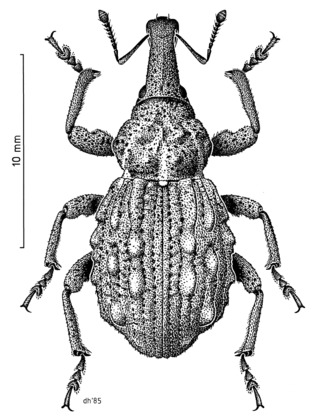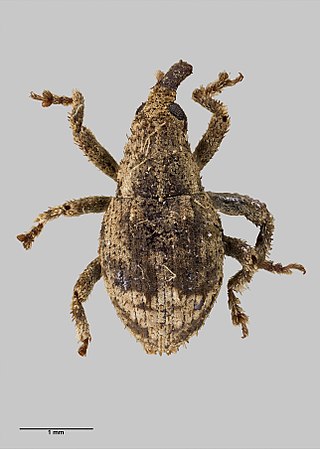
Weevils are beetles belonging to the superfamily Curculionoidea, known for their elongated snouts. They are usually small – less than 6 mm in length – and herbivorous. Approximately 97,000 species of weevils are known. They belong to several families, with most of them in the family Curculionidae. It also includes bark beetles, which while morphologically dissimilar to other weevils in lacking the distinctive snout, is a subfamily of Curculionidae. Some other beetles, although not closely related, bear the name "weevil", such as the biscuit weevil, which belongs to the family Ptinidae.

Hadramphus tuberculatus is a rare weevil endemic to Canterbury in the South Island of New Zealand. It was thought to be extinct in 1922 but was rediscovered in 2004 but is extinct.

Otiorhynchus is a large genus of weevils in the family Curculionidae. Many species of the genus, particularly the black vine weevil and the strawberry root weevil, are important pests, both as larvae and as adults. Larvae feed on plant roots. Adults are flightless with fused elytra and feed at night on plant foliage. In many species of the genus at least some races are polyploid and parthenogenetic, while the rest of the races and species are diploid and bisexual. Otiorhynchus weevils, particularly O. scaber, have been a popular subject for studies of the evolution of parthenogenesis. The genus is native to the Palearctic region. However, sixteen species were inadvertently introduced to North America and have become widespread there.

Sitona is a large genus of weevils in the family Curculionidae native to the Nearctic and Palaearctic regions. Over 100 species have been described. Sitona is easily distinguished from related genera by flat, recumbent scales on the mandibles, by the absence of an oval scar on the mandibles, by short and broad rostrum with a deep, longitudinal, median groove, and by dense scales on the body.

Hadramphus, commonly known as knobbled weevils, is a genus of flightless molytine weevils from the family Curculionidae. It is endemic to New Zealand and consists of four species.

Rhynchophorus, or common name palm weevils, is a genus of beetles in the weevil family, Curculionidae. Palm weevils are major pests of various trees in the family Arecaceae throughout the tropics including: coconut, Areca catechu, species of the genus Phoenix, and Metroxylon sagu. Two species are invasive pests outside their native ranges, Rhynchophorus ferrugineus and Rhynchophorus palmarum.

Didymus is a genus of beetles known as weevils. The genus contains the following species:
Pachnaeus opalus, the northern citrus root weevil, is a species of broad-nosed weevil in the family Curculionidae. It is found in North America.

Pachnaeus is a genus of broad-nosed weevils in the family Curculionidae. There are about seven described species in Pachnaeus.

Artipus floridanus, the little leaf notcher, is a species of broad-nosed weevil in the beetle family Curculionidae. It is found in North America.

Artipus is a genus of broad-nosed weevils in the beetle family Curculionidae. There are about 10 described species in Artipus.

Myllocerus undecimpustulatus, known generally as the Sri Lanka weevil or yellow-headed ravenous weevil, is a species of oriental broad-nosed weevil in the beetle family Curculionidae. It damages crops and is resistant to controls. It has spread.

Myllocerus is a genus of oriental broad-nosed weevils in the beetle family Curculionidae. There are at least 330 described species in Myllocerus.

Naupactus cervinus, the Fuller rose beetle, is a species of broad-nosed weevil in the family Curculionidae.

Otiorhynchus crataegi, the privet weevil, is a species of broad-nosed weevil in the beetle family Curculionidae.

Pseudocneorhinus bifasciatus, the twobanded Japanese weevil, is a species of broad-nosed weevil in the beetle family Curculionidae.

Pseudocneorhinus is a genus of broad-nosed weevils in the beetle family Curculionidae. There are about 11 described species in Pseudocneorhinus.

Tropiphorus elevatus is a species of broad-nosed weevil in the beetle family Curculionidae.

Tropiphorus is a genus of broad-nosed weevils in the beetle family Curculionidae. There are about 18 described species in Tropiphorus.

Brachyolus is a genus of broad-nosed weevil in the family Curculionidae.















